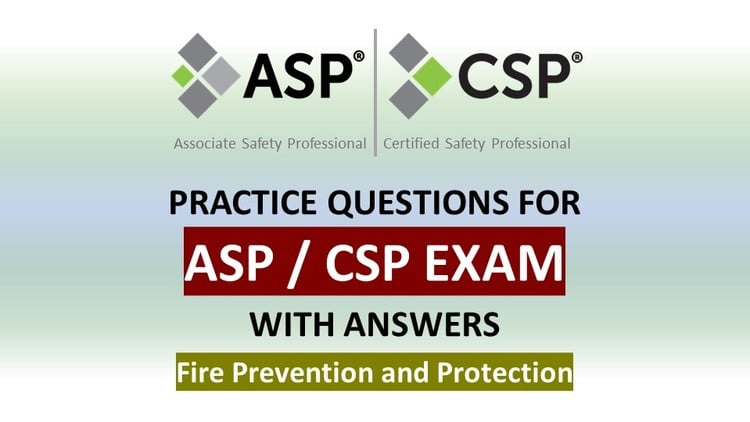
Occupational Health and Safety
What you will learn
Acquiring the necessary skills to pass the ASP/CSP exam – Fire Prevention and Protection
Demonstrate Knowledge of Fire Protection Principles
Identify and Assess Fire Hazards
Develop Effective Fire Prevention Plans
Understand Fire Protection Systems and Equipment
Why take this course?
This comprehensive training course is designed to equip Associate Safety Professionals (ASPs) and Certified Safety Professionals (CSPs) with the essential knowledge and skills to effectively manage fire protection programs within their organizations. Participants will gain a deep understanding of fire prevention, detection, suppression, and response strategies, enabling them to identify and mitigate fire hazards, comply with relevant regulations, and ensure workplace safety.
Key Learning Objectives
- Fire Safety Fundamentals:
- Understand the principles of fire behavior, including the fire triangle and the four stages of fire development.
- Learn about common causes of fires in industrial, commercial, and residential settings.
- Fire Prevention and Protection Measures:
- Explore fire prevention strategies, such as hazard identification, risk assessment, and the implementation of preventive measures.
- Study fire protection systems, including sprinkler systems, fire alarms, and fire extinguishers, and their proper installation, maintenance, and testing.
- Fire Detection and Response:
- Learn about various fire detection technologies, including smoke detectors, heat detectors, and flame detectors.
- Develop effective fire emergency response plans, including evacuation procedures, firefighting techniques, and post-fire investigations.
- Fire Safety Regulations and Standards:
- Gain a comprehensive understanding of relevant fire safety regulations, codes, and standards, such as NFPA, OSHA, and local building codes.
- Learn how to ensure compliance with these regulations and standards.
- Fire Investigation and Analysis:
- Explore the process of conducting fire investigations, including evidence collection, analysis, and determination of the cause and origin of fires.
- Develop skills in documenting and reporting fire investigation findings.
Target Audience
This course is ideal for:
Note➛ Make sure your 𝐔𝐝𝐞𝐦𝐲 cart has only this course you're going to enroll it now, Remove all other courses from the 𝐔𝐝𝐞𝐦𝐲 cart before Enrolling!
- Associate Safety Professionals (ASPs)
- Certified Safety Professionals (CSPs)
- Safety managers
- Risk managers
- Facility managers
- Fire safety officers
Course Benefits
- Enhanced knowledge of fire safety principles and practices
- Improved ability to identify and mitigate fire hazards
- Increased confidence in managing fire protection programs
- Enhanced compliance with fire safety regulations
- Improved emergency response capabilities
English
Add-On Information:
“`html
- Master the core principles of fire science and behavior essential for safeguarding workplaces.
- Deeply understand the regulatory landscape, including OSHA standards, NFPA codes, and other relevant guidelines.
- Develop expertise in identifying, evaluating, and controlling fire hazards in diverse occupational settings.
- Learn to design and implement effective fire prevention programs, encompassing training, maintenance, and emergency preparedness.
- Gain proficiency in selecting and utilizing appropriate fire suppression systems, alarms, and detection technologies.
- Acquire skills in conducting thorough fire risk assessments and developing mitigation strategies.
- Understand the human factors contributing to fire incidents and how to foster a strong safety culture.
- Prepare for the comprehensive knowledge required for the Associate Safety Professional (ASP) and Certified Safety Professional (CSP) exams, specifically focusing on the fire safety domain.
- Enhance your ability to interpret and apply complex fire codes and standards to real-world scenarios.
- Practice exam-taking strategies and critical thinking skills needed to confidently answer challenging questions.
- Explore the intricacies of building design and construction in relation to fire resistance and compartmentalization.
- Learn about the management of hazardous materials and their specific fire risks and controls.
- Familiarize yourself with the principles of emergency response planning and evacuation procedures.
- Understand the role of incident investigation in preventing future fire occurrences.
- Gain insight into the latest advancements and best practices in fire prevention and protection technology.
- Strengthen your understanding of life safety systems and their integration into overall building safety.
- PRO: This course provides targeted preparation for specific certification exams, enhancing career advancement opportunities.
- PRO: The knowledge gained is directly applicable to improving workplace safety and reducing fire-related risks and losses.
- PRO: Develops a specialized skill set highly valued in the occupational health and safety field.
- CONS: Requires a foundational understanding of general safety principles to fully benefit from the specialized fire content.
“`
language
Found It Free? Share It Fast!